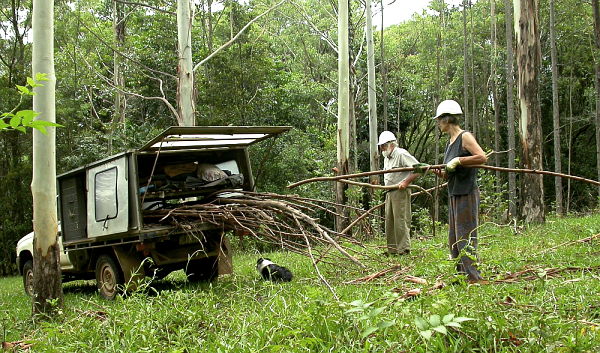Trees and wood
|
|
Trees and wood |
In late 1976 we moved onto a 256 acre ex-dairy farm, half of which was rainforest which had been logged but which was still a functioning rainforest ecosystem. The other half of the farm had been ruthlessly cleared and was covered with grass, lantana and some regrowth trees. The soil is mainly a dark red iron bearing kaolinitic clay which had very low fertility after the original rainforest humus had been washed away. The hills are quite steep and there were a number places where heavy rainfall and lack of vegetation had resulted in soil slippage. We fenced areas to prevent the cattle destroying regrowth, and to keep them from destroying the trees which we started planting immediately. We planted trees for timber, for fuel for the kitchen and kilns, for the restoration of the farm, and for pleasure.
|
The image at right is from about 1950. We still live in the same house although it has been extended. Intact rainforest can be seen in the distance, and the timber on the hill at left centre had only recently been cleared. The property had been occupied since 1937. |
|
|
This is a view from our house in late 1976. The ugly scar at the left marks the line where a road has been carved from the hillside clay so trucks could haul away logs. |
|
|
The same scene in late 1999. The photo below is an overlay of the two images just in case you are not entirely convinced. Carol, holding a red umbrella, is standing next to a Flooded Gum (Eucalyptus grandis) which she held in the palm of her hand the day we planted it. This tree is now 26 metres (85 feet feet) high. The white barked trees in the background are also Flooded Gums , and were planted at the same time. They are competing to reach the light and the tallest of these reaches to 48 metres (157 feet). |
|
|
The tree in the right foreground of the smaller image is a Blackwood (Acacia melanoxylon). This is a pioneer regrowth species here and has remarkable properties: it fixes nitrogen so that soil fertility is improved, it produces prodigious amounts of ash glaze and few coals in kiln fireboxes, and the wood is beautifully coloured and marked. Some of the walls of our house are lined with Blackwood cut from a tree on our land (with a chainsaw mill). Cattle find the leaves very palatable. Some specimens have a short lifespan, and the one in the photo was one of these. |
|
 Collecting Flooded Gum branches in a 14 year plantation 2008 | |
Wood for Kilns
Of
the many tree species which grow on our land only Flooded Gum and
Blackwood are used for firing our kilns. Having planted more than
10,000 trees and aided the growth of many more thousands we are
relaxed about burning a few in the kilns. Nearly always we
avoid cutting our own as we have neighbours and road workers who
dedicate their lives to disciplining Blackwoods. If Flooded
Gums are planted close together they develop a self pruning mechanism
which yields branch free trunks. The prunings provide excellent
wood for sidestoking the anagama, but they drop from great heights,
making collection a hazardous job. Flooded Gums are very
similar to Sydney Blue Gums (Eucalyptus saligna), and as
eucalypts go they are not particularly hard or dense.
We also use
Forest Red Gum (Eucalyptus tereticornis), also called Blue
Gum, in our kilns. This does not grow on our property but is
used for timber and we collect unused branches from trees felled in a
State Forest. Blue Gum is one of those very dense and hard Australian
hardwoods which provides lots of heat and coals in a kiln. The
salt kilns are usually fired with a mixture of Blue Gum and
Blackwood.